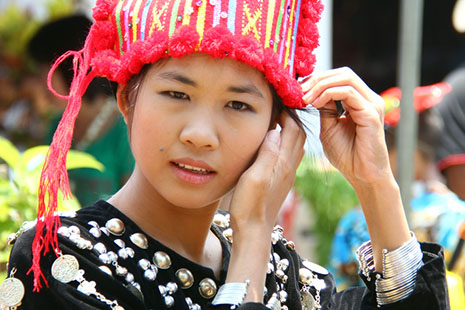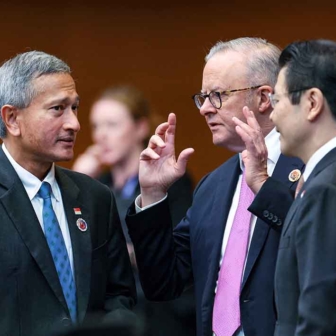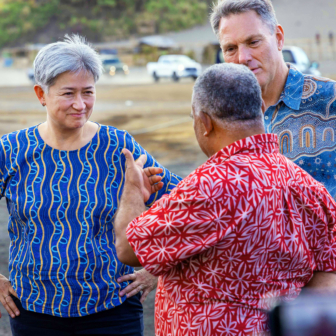WITH its manicured grounds, vast government compounds, sprawling hotels and eye-popping religious sites, Burma’s new capital, Naypyidaw, was built for giants. Twelve-lane motorways intersect with oversized ornamental roundabouts. Battalions of gardeners are kept busy trimming miles of hedges and tending millions of flowers and trees. Official motorcades whiz past gleaming monuments to dictatorial pirouettes and democratic transition.
The city, knowingly called “our Canberra” by some government insiders, is at the heart of an unprecedented effort to bring popular participation into Burmese politics and to develop a modern economy. This audacious national repositioning is behind the billion-dollar investments that have seen Naypyidaw cut from the scrub and paddy fields of the country’s central plains.
The city’s layout – zoned to keep residential, commercial, hotel, government and military infrastructure separate – stretches to the horizon and beyond. In a country of haphazard urban planning, erratic electricity supplies and cramped, potholed streets, Naypyidaw’s precision is a striking contrast.
Everything is new in the capital, including the system of government. The State Peace and Development Council – the notoriously tough-minded military clique that dominated national life until 2010 – has been dissolved and a system of regional and national legislatures introduced. While much is made of the 25 per cent of seats in the legislatures allocated to military personnel, it’s important to remember that there are 1158 elected politicians in Burma today.
The electoral institutions they are building form the bedrock of the reforms led by President Thein Sein. It is without doubt a curious historical turn. The president heads a government supported by the Union Solidarity and Development Party, the lineal descendent of the old military dictatorship. Thein Sein himself was previously the fourth-ranking officer in the military hierarchy, but his reputation for firm administration has been mellowed by what many interpret as an unquenched appetite for political transformation. Whatever his past sins and priorities, Thein Sein has been reincarnated late in life as an aggressive and creative liberaliser.
In Burma’s political history he will always be remembered as the former general who gave Aung San Suu Kyi a chance to show her political mettle. Her election to parliament in April 2012 demonstrated that Thein Sein is prepared to work with the National League for Democracy and tolerate its calls for even more radical political change. He has judged the popular mood well. Even the public servants of the new capital have shown their true colours: Aung San Suu Kyi’s party swept to victory in the four seats in Naypyidaw contested in the April 2012 by-election.
Since then, and with nearly 7 per cent of seats in the lower house of the national parliament, the National League for Democracy is poised for further wins, even dominance, in the 2015 general election. There is an overwhelming expectation that Aung San Suu Kyi’s democrats will storm to power as soon as they get a chance. Their destiny, frustratingly delayed, is now being propelled by Thein Sein’s reforms. Such a significant reconfiguration of national politics is cause for much celebration and optimism.
But the most troubling and challenging issue in Burmese political life – ethnic politics – remains unresolved and will take a gigantic effort to fix.
For a start, President Thein Sein’s government inherits an unwieldy administrative geography weighted across seven ethnic majority states and seven Burman majority regions. According to the official classification there are eight main ethnic groups – Burman, Chin, Kachin, Karen, Karenni, Mon, Shan and Rakhine – but anthropologists, and government record-keepers, tell us there are more than a hundred groups in total. This spectacular ethnic diversity has never been reflected in the distribution of political or economic power.
Since independence, leaders of the Burman majority have insisted that their political stewardship is inviolable. They have convinced themselves that the disparate ethnic minorities could not be trusted with real power. This has led to a climate of mistrust and fear that has often descended into hostilities, even civil war.
The original sin of Burma’s founding fathers is that they did not organise a mechanism to generate processes of ethnic harmonisation and autonomy. The resulting civil wars have seen countless thousands killed, perhaps as many as half a million people in total.
The wounds naturally lie deep in all sections of society. Some ethnic groups have maintained an almost constant war footing for decades. Untold ethnic Burman families, villages and towns have seen their boys march off to battle, never to return.
The fact that around 30 per cent of Burma’s population comes from an ethnic and linguistic minority group is a headache for the government. In schools, it complicates efforts to implement a single national language policy. In the economy it leads to cries of favouritism and unfair advantage. Whatever they do, officials are liable to be criticised for their xenophobia and lack of sensitivity to cultural diversity.
Certainly, there have been great efforts to emphasise ethnic harmony. T-shirts with the slogan “Happyland Myanmar” present the eight main ethnic groups in distinctive national dress. In government-sponsored cultural performances the unity of the ethnic groups is constantly reasserted. Major events and speeches make obligatory references to the great diversity of the country’s peoples. Every day of the year, television broadcasts and newspapers are filled with exhortations to cultivate inter-ethnic solidarity.
These presentations largely ignore the resentments, hardships and horrors that have dominated Burma’s inter-ethnic relations. Trust is a rare commodity, and even after more than twenty years of ceasefires in many former war zones, ingrained scepticism persists about the priorities of central government authorities, including Thein Sein. Brutal counterinsurgency campaigns of the sort that Thein Sein and his close associates commanded have left behind a legacy of confusion and hatred.
All of this means that ending Burma’s civil wars, once and for all, is an obvious but thorny priority for Thein Sein’s government. His advisers insist that they are doing their best to untangle the mess inherited from the military dictatorship. Their efforts to distance current government policy from the previous regime won’t convince hardened sceptics, but they do provide some space for new initiatives.
WITH goodwill and persistence, not to mention a certain level of courage, Burma could resolve its longstanding ethnic political disorder.
The first step is for the government to confirm temporary ceasefire agreements with all of the ethnic armies. This will not be easy. There are still a number of hot civil wars, most particularly in Shan and Kachin areas, which will require careful treatment from the government side.
The war with the Kachin Independence Army is the most complicated. It reignited on 9 June last year after a seventeen-year ceasefire. Since then there have been hundreds of skirmishes, ambushes and assaults. Both sides have sustained losses, but most indications suggest that the government has borne the brunt of aggressive guerrilla tactics. It may have already lost thousands of troops in the new war.
To break the deadlock, the government has recently reorganised its negotiating team and is seeking opportunities for fresh truce discussions. With both sides recognising that the renewed war is unsustainable there is a chance that a new Kachin deal could emerge at any time.
Once ceasefires are in place across the country, and Burma is at peace with itself for the very first time, the government has an unprecedented opportunity. But capitalising on this opportunity will prove more challenging than many imagine. Ethnic minority leaders have a sophisticated awareness of their essential role in a more peaceful, prosperous and democratic Burma. The average leader from the ethnic side is a middle-aged, battle-hardened and commercially savvy political operator who has lived through decades of awkward compromises and half-deals.
These leaders understand that Burma’s increasing relevance to Western policy-makers is beginning to change the equation for their groups as well. Their sympathies generally lie with Aung San Suu Kyi, although they can be ferocious in their criticisms of her perceived missteps. Many ethnic leaders worry that she fails to fully appreciate the implications of decades-long civil wars; others fear that Aung San Suu Kyi could be captured by latent Burman chauvinism. Her muted response to recent violence against the Rohingya minority in western Burma has not helped to increase their enthusiasm.
In negotiating with so many ethnic minority leaders the government will need to launch a national-level conversation about ethnicity leading, ideally, towards a comprehensive political settlement that involves all ethnic groups at once.
Burmese government insiders suggest that thoroughly recalibrating the ethnic situation will take time and patience. Broad questions of belonging and citizenship are likely to prove contentious. This is especially true once more exiles begin to return home. Will they be considered full partners in the country’s future? What about the millions of Burmese citizens, many of whom are from ethnic minorities, who have been working as wage labourers in Thailand and Malaysia? Their dreams of returning to a peaceful and democratic Burma rely on an inclusive political process that can draw strength from its diversity.
The return of these Burmese has untold potential. The countless number who now, after years labouring elsewhere in the region, speak other languages is a remarkable asset. The quality of English that will be spoken in Burma, not to mention the Thai, Malay and Chinese, will provide a huge advantage if the government can peacefully reintegrate the teeming diaspora. Pluralism will need to be given the prominence it deserves.
For this reason the resolution of Burma’s ethnic issues has much broader significance. It could ultimately generate an inclusive political system that will not only benefit ethnic minorities. It could be designed as a key part of any effort to draw on all of the country’s political, social and economic resources in a way that has never been possible before.
The whole process is daunting, and the risks should not be underestimated. Such historic reforms require equal measures of savviness, resilience and luck. They also require leadership.
From his office in Naypyidaw President Thein Sein governs from a city built on a monumental scale. As the first president of the reformist era – the man entrusted with getting Burma’s new electoral system off to a promising start – the ethnic conflicts remain his most significant challenge.
The community also recognises the historic opportunity of Naypyidaw’s parliamentary era. In 2012 Thein Sein was nominated for the Nobel Peace Prize. One of the reasons the nomination was premature is that ethnic conflicts, like the one in Kachin State, continue to rage.
But whoever manages to resolve these persistent enmities will surely deserve the highest accolades. Thein Sein and his colleagues are working to seize this chance for peace, but they may only have until 2015 when the National League for Democracy is likely to come to power. In that sense, the clock is ticking. If they succeed, Naypyidaw has more than enough room to erect statues of peace-making giants. •




